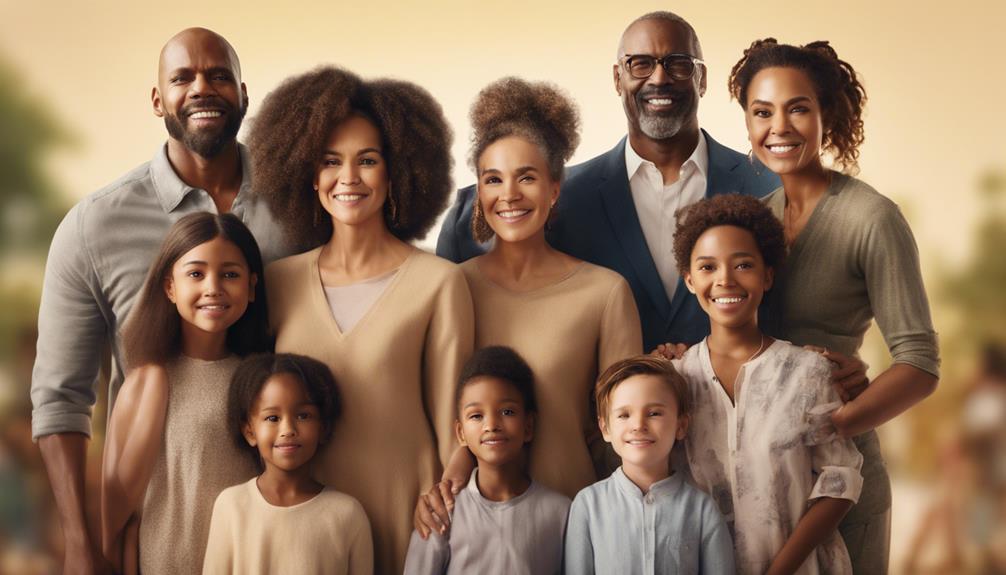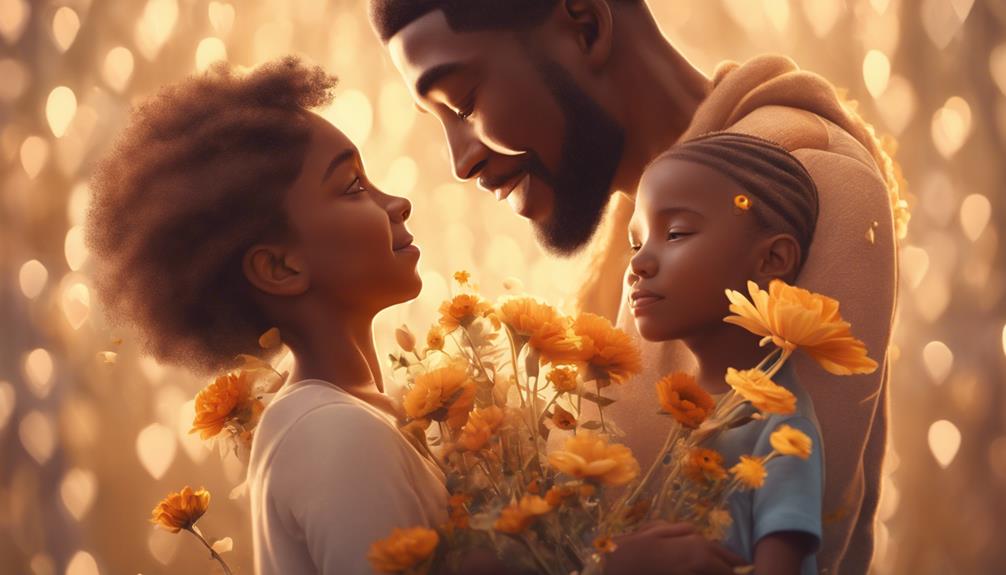Celebrities often navigate the complex dynamics of blended families, where integrating children from previous relationships requires patience, empathy, and effective communication. Examples of celebrity blended families include Gisele Bündchen and Tom Brady, Drew Barrymore and Will Kopelman, and Demi Moore and Bruce Willis. Key components of successful blended families include open communication, empathy, and unity. Prioritizing children's well-being, fostering unity, and cultivating kindness are essential in creating harmony at home. By embracing differences in parenting styles and showing love beyond biological ties, blended families can thrive. As they explore the intricacies of blended families, they'll discover more about the delicate balance of love, respect, and cooperation.
Key Takeaways
• Effective communication and empathy are crucial in navigating the challenges of blended families, as seen in celebrity examples like Gisele Bündchen and Tom Brady.
• Prioritizing children's well-being and maintaining open communication are essential in co-parenting relationships, even for celebrities like Drew Barrymore and Will Kopelman.
• Fostering unity and harmony at home is vital for children's emotional security, as demonstrated by Gabrielle Union and Dwyane Wade's blended family.
• Love and acceptance can transcend traditional family structures, as seen in the strong bonds between step-parents and children in blended families like Demi Moore and Bruce Willis's.
• Mutual respect, positive relationships, and unity are key components of successful blended families, as exemplified by celebrities like Megan Fox and Machine Gun Kelly.
Blended Family Challenges
Blending families involves maneuvering through a complex web of emotions, where unresolved feelings from past relationships and uncertain expectations about the new family dynamic can create a perfect storm of conflict. In a blended family, children often carry emotional scars from their parents' separation, making it essential to address these emotional complexities with empathy and patience.
Varied household rules can lead to disagreements and friction among family members, highlighting the need for effective communication to resolve conflicts. The process of blending families can be both fulfilling and demanding, requiring a deep understanding of the challenges involved. Key components in successfully managing these challenges include effective communication, empathy, and patience.
Celebrity Blended Family Examples

Many celebrity blended families have successfully managed the challenges of co-parenting, offering inspiring examples for others to follow.
Gisele Bündchen, Tom Brady, and Bridget Moynahan showcase successful co-parenting dynamics, demonstrating that a harmonious blended family is achievable.
Similarly, Drew Barrymore, Will Kopelman, and Allie Michler prioritize co-parenting their children, highlighting the importance of putting kids first.
Demi Moore, Bruce Willis, and Emma Heming Willis exemplify a close bond despite divorce, proving that a harmonious relationship is possible even after separation.
Megan Fox, Machine Gun Kelly, and Brian Austin Green co-parent harmoniously, showing that love and acceptance can prevail.
Gabrielle Union and Dwyane Wade prioritize love and acceptance in their blended family, setting a positive example for their kids.
These celebrity blended families serve as examples of successful co-parenting, offering hope and inspiration to others managing the complexities of blended family dynamics.
Navigating Co-Parenting Relationships

As celebrity blended families like Gisele Bündchen and Tom Brady's demonstrate, managing co-parenting relationships requires a deep commitment to prioritizing the well-being of the children. Effective co-parenting is vital in blended families, where multiple parental figures are involved. Celebrities like Drew Barrymore and Will Kopelman, Demi Moore and Bruce Willis, and Kate Hudson and Danny Fujikawa are examples of successful co-parenting relationships.
Key elements of successful co-parenting in blended families include:
- Prioritizing the children's well-being above personal differences
- Maintaining open communication channels with all parental figures
- Fostering a sense of unity and consistency across households
- Embracing each other's differences and parenting styles
- Cultivating a spirit of kindness, empathy, and understanding
Gwyneth Paltrow, Jennifer Lopez, and Jennifer Garner are among the many celebrities who've navigated co-parenting relationships in their blended families. By learning from their experiences, we can gain valuable insights into what makes co-parenting essential.
Creating Harmony at Home

Nearly all successful blended families in Hollywood, including those of Gwyneth Paltrow and Jennifer Lopez, showcase a deep understanding that creating harmony at home is essential to their children's well-being. These families prioritize cooperation and unity, recognizing that a harmonious environment promotes stability and well-being for their children. By focusing on building strong family bonds and relationships, they create an atmosphere of acceptance and support.
| Family Aspect | Importance | Benefit |
|---|---|---|
| Harmony | Essential for children's well-being | Promotes stability |
| Cooperation | Fosters unity and teamwork | Encourages open communication |
| Unity | Strengthens family bonds | Creates a sense of belonging |
| Acceptance | Breaks down barriers | Fosters a nurturing environment |
| Support | Provides emotional security | Enhances overall well-being |
Love Beyond Biological Ties

Celebrity blended families, like Dakota Johnson's, exemplify love that seamlessly transcends biological ties, fostering strong bonds between step-parents and children. This love and acceptance go beyond traditional family structures, creating a sense of unity and harmony within the family unit.
The dynamics of blended families prioritize mutual respect and positive relationships, allowing children to form close bonds with half-siblings and step-parents. This is evident in the way step-parents, like Dakota Johnson, embrace their roles with genuine care and support.
Some key aspects of love beyond biological ties in blended families include:
- Acceptance of all family members, regardless of biological relationships
- Strong bonds formed between step-parents and children
- Mutual respect and positive relationships among all family members
- A sense of unity and harmony within the family unit
- Love and care that transcends traditional family structures
Frequently Asked Questions
Who Has the Most Difficulty Adjusting in a Blended Family?
Children typically have the most difficulty adjusting in a blended family. Younger children struggle with sharing attention and resources, while teenagers face challenges in accepting new authority figures and adapting to different parenting styles.
This adjustment can be particularly tough for children who may feel a sense of loyalty conflict between their biological parent and new blended family. Effective communication, patience, and understanding are essential in helping children navigate these adjustments.
What Is the Divorce Rate for Blended Families?
Approximately 60-70% of blended families end in divorce, a rate higher than that of first marriages. This elevated divorce rate is attributed to complex family dynamics, financial stress, and parenting conflicts, which can strain relationships and increase the likelihood of divorce.
Effective communication, conflict resolution skills, and family therapy can help mitigate these challenges and reduce the risk of divorce in blended families.
What TV Show Is an Example of a Blended Family?
Surprisingly, 16% of remarriages in the United States involve blended families.
One popular TV show that exemplifies a blended family dynamic is 'Modern Family'.
The show features three different family units coming together through marriage and adoption, showcasing the challenges and joys of managing relationships in a blended family.
What Is the Conflict Theory of Blended Families?
The Conflict Theory of Blended Families proposes that power struggles and competition for resources within the family unit lead to conflicts. These conflicts arise from differences in values, traditions, and parenting styles among family members.
Unresolved conflicts can negatively impact family dynamics and relationships. According to the theory, open communication and mutual understanding are essential in resolving conflicts and promoting harmony within the blended family structure.
Conclusion
To sum up, blended celebrity families navigate complex relationships, co-parenting dynamics, and harmonious home environments. Like any family, they face challenges, but with effort, commitment, and love, they thrive.
By recognizing the importance of open communication, respect, and empathy, blended families can flourish, demonstrating that love knows no biological bounds.
As these celebrity examples illustrate, with dedication and hard work, blended families can become a beautiful, loving, and supportive unit.










